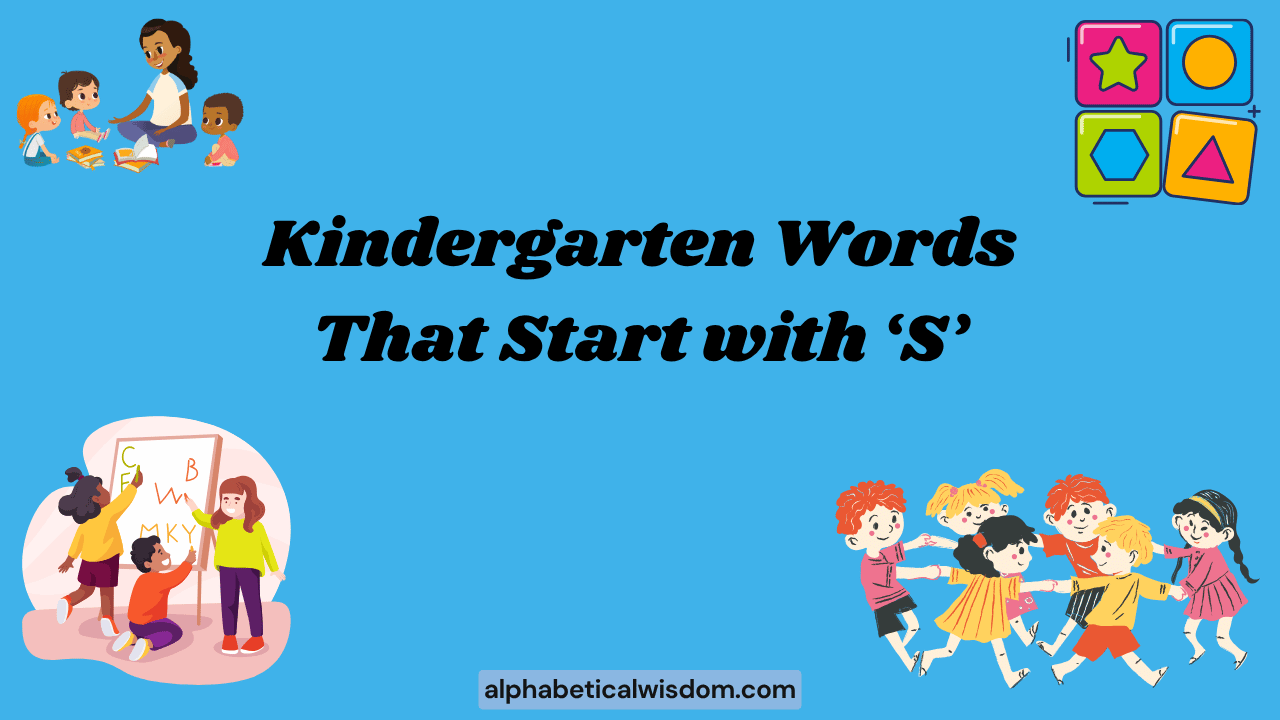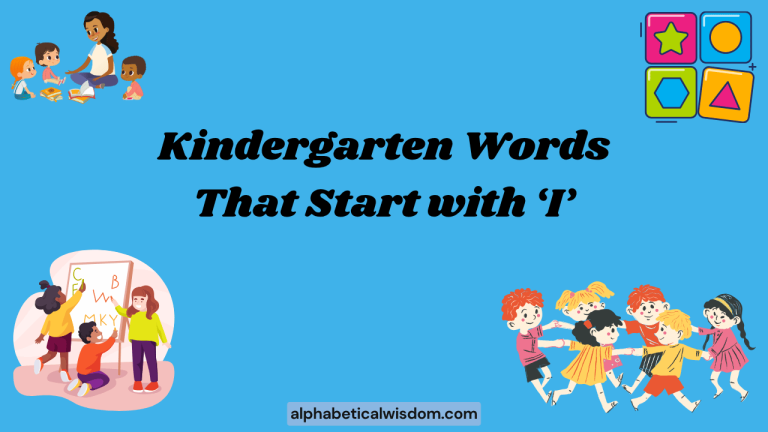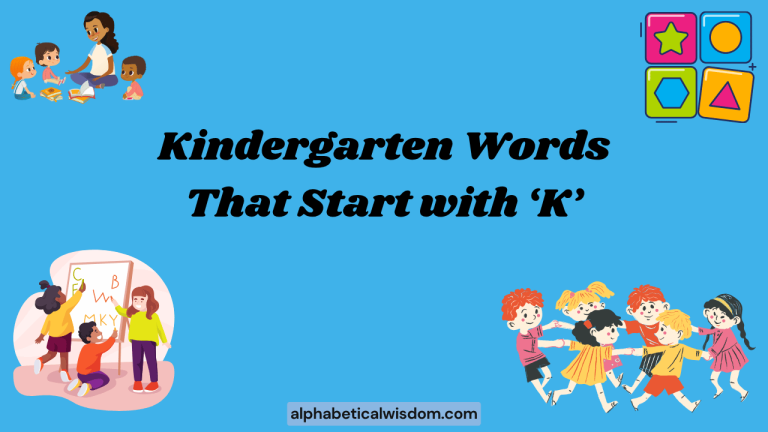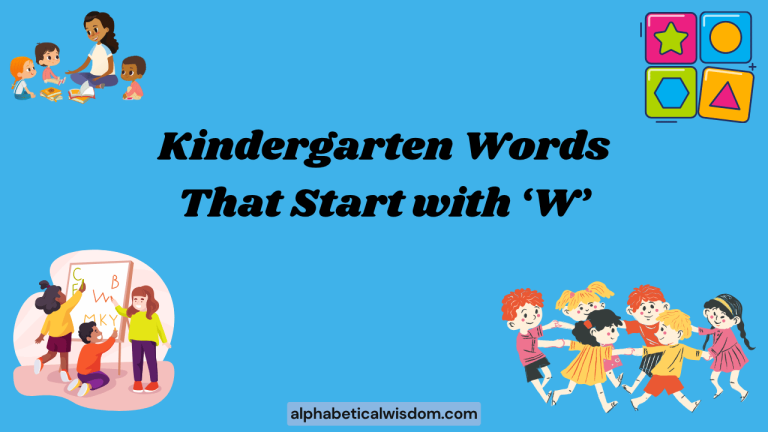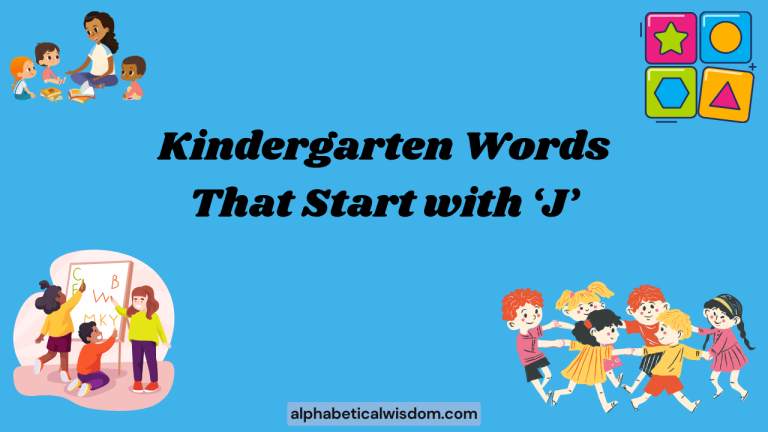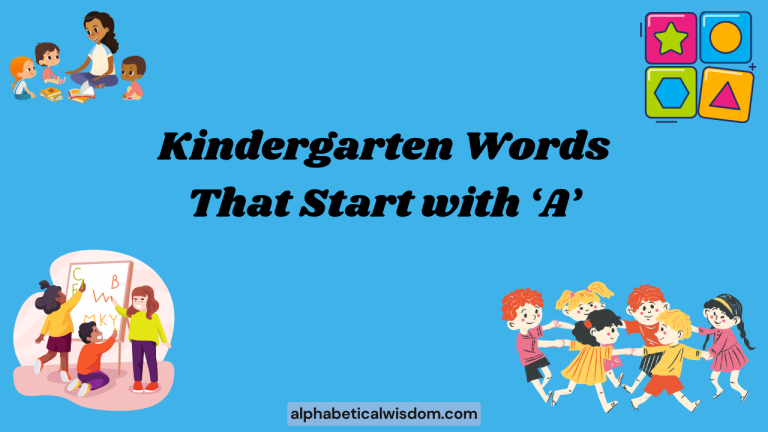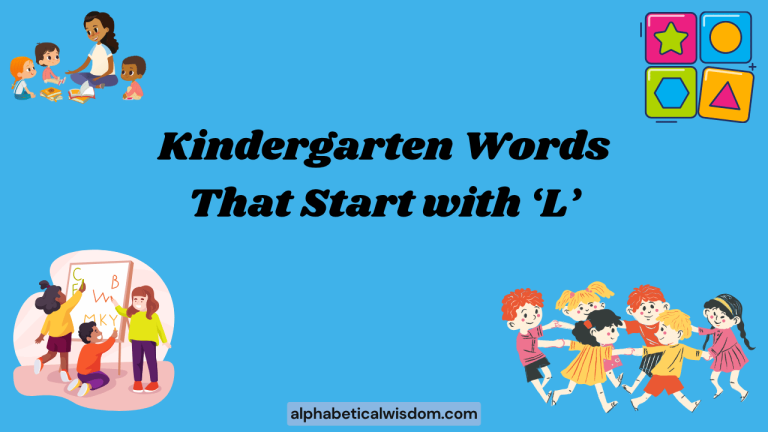Kindergarten Words Starting With S: A Comprehensive Guide
Understanding words that start with the letter “S” is a foundational step in a child’s literacy journey. These words are not only common in everyday language but also crucial for building vocabulary and reading skills.
This article provides a comprehensive guide to kindergarten words starting with “S,” offering definitions, examples, usage rules, and practice exercises. It aims to support parents, teachers, and young learners in mastering these essential words, setting a strong base for future language development and academic success.
By exploring these words, children will enhance their ability to communicate effectively and confidently.
Table of Contents
- Introduction
- Definition of Kindergarten Words Starting With S
- Structural Breakdown of Words Starting With S
- Types and Categories of “S” Words
- Examples of Kindergarten Words Starting With S
- Usage Rules for “S” Words
- Common Mistakes with “S” Words
- Practice Exercises
- Advanced Topics: Exploring “S” Sounds and Digraphs
- Frequently Asked Questions (FAQ)
- Conclusion
Introduction
The letter “S” is one of the most frequently used letters in the English language, and mastering words that begin with it is essential for kindergarteners. These words form the building blocks of sentences and stories, enabling young children to express themselves and understand the world around them.
This article serves as a complete resource, offering a detailed exploration of kindergarten-level words starting with “S.” It covers everything from basic definitions to advanced usage, ensuring a solid understanding of these fundamental words. Whether you are a parent, teacher, or student, this guide will help you enhance your vocabulary and language skills effectively.
The ability to recognize and use “S” words confidently is a key indicator of early literacy. This skill not only improves reading comprehension but also boosts writing abilities.
By engaging with the examples and exercises provided in this article, children will develop a strong foundation in phonics and vocabulary. This, in turn, will foster a lifelong love of reading and learning.
The focus on practical application and real-world examples ensures that the knowledge gained is both meaningful and memorable.
Definition of Kindergarten Words Starting With S
Kindergarten words starting with “S” are basic vocabulary terms that are typically introduced to children between the ages of 4 and 6. These words are selected for their simplicity, relevance to a child’s everyday experiences, and their contribution to early reading and writing skills.
They often represent concrete objects, actions, or concepts that children can easily understand and relate to. The definition of each word includes its meaning, part of speech, and context in which it is used.
These words are carefully chosen to align with the developmental stage of kindergarteners. They are designed to be phonetically simple, making them easier to decode and pronounce.
Moreover, they frequently appear in children’s books and educational materials, reinforcing their importance in early literacy. By mastering these words, children gain confidence in their ability to read, write, and communicate effectively.
Structural Breakdown of Words Starting With S
Understanding the structure of words starting with “S” involves recognizing the letter “S” as the initial sound and identifying the subsequent letters that form the rest of the word. Many of these words follow a simple consonant-vowel-consonant (CVC) pattern, which is a common structure in early reading materials.
Analyzing the phonetic components of these words helps children to decode and pronounce them accurately.
For example, the word “sun” follows the CVC pattern, with “s” as the consonant, “u” as the vowel, and “n” as the final consonant. Similarly, “sit” also adheres to this pattern.
Breaking down words into their individual sounds (phonemes) and corresponding letters (graphemes) is a fundamental skill in phonics instruction. This approach enables children to develop a systematic understanding of how letters and sounds work together to form words.
Additionally, some “S” words may include consonant blends, such as “st” in “stop” or “sp” in “spin.” Recognizing these blends is an important step in developing more advanced decoding skills. These blends introduce more complex phonetic structures, preparing children for more challenging words as they progress in their reading journey.
Types and Categories of “S” Words
1. Nouns
Nouns are words that name people, places, things, or ideas. Kindergarten “S” nouns often refer to objects or concepts that are familiar to young children.
2. Verbs
Verbs are words that describe actions or states of being. Kindergarten “S” verbs typically represent simple actions that children can easily understand and perform.
3. Adjectives
Adjectives are words that describe nouns. Kindergarten “S” adjectives are used to describe the qualities or characteristics of objects or people.
4. Sight Words
Sight words are words that are frequently encountered but may not follow typical phonetic rules. These words are often memorized by sight to improve reading fluency.
Several common sight words start with “S.”
Examples of Kindergarten Words Starting With S
The following tables provide extensive examples of kindergarten words starting with “S,” categorized by their part of speech. Each table includes definitions and example sentences to illustrate how the words are used in context.
These examples are designed to be clear, simple, and relevant to the experiences of young learners.
Nouns Starting With S
Nouns are essential for naming objects and concepts. The following table lists common nouns starting with “S” that are appropriate for kindergarteners.
| Word | Definition | Example Sentence |
|---|---|---|
| Sun | The star that provides light and heat to Earth. | The sun is shining brightly today. |
| Star | A luminous celestial body. | I see a star in the night sky. |
| Sand | Tiny grains of rock, often found on beaches. | We built a castle with sand. |
| Sock | A covering for the foot, worn inside a shoe. | I need to find my other sock. |
| Soup | A liquid dish, typically made by boiling meat, vegetables, or both in stock or water. | I like to eat hot soup when it’s cold. |
| Snake | A long, limbless reptile. | The snake slithered through the grass. |
| Seed | A small embryonic plant enclosed in a covering. | We planted a seed in the garden. |
| Sky | The atmosphere above the Earth. | The sky is blue and clear today. |
| Smile | A facial expression indicating happiness. | She has a big smile on her face. |
| Snow | Frozen precipitation in the form of white or translucent ice crystals. | The snow is falling softly outside. |
| Squirrel | A small rodent with a bushy tail. | A squirrel is eating nuts in the tree. |
| Shirt | A garment for the upper body. | I need to wear a clean shirt today. |
| Shoe | A covering for the foot, typically made of leather or other sturdy material. | My shoe is untied. |
| Sister | A female sibling. | My sister is my best friend. |
| Song | A musical composition with lyrics. | We sang a song in music class. |
| Story | An account of imaginary or real people and events told for entertainment. | I like to read a story before bed. |
| Swing | A seat hanging from above, used for swinging back and forth. | I love to play on the swing. |
| Screen | The part of a television or computer that shows images or text. | I watch cartoons on the screen. |
| Stamp | A small piece of paper with adhesive on the back, used to pay postage. | I put a stamp on the envelope. |
| Street | A public road in a city or town. | We live on a quiet street. |
| Station | A place where trains or buses regularly stop. | The train arrived at the station. |
| Salad | A cold dish of various mixtures, typically of raw vegetables. | I like to eat a salad with my lunch. |
| Shadow | A dark area or shape produced by a body coming between rays of light and a surface. | The tree cast a long shadow in the afternoon. |
| Shelf | A flat length of wood or rigid material, attached to a wall or forming part of a piece of furniture, that provides a surface for the storage or display of objects. | I put my books on the shelf. |
| Shell | The hard protective outer case of a mollusk or crustacean. | I found a beautiful shell on the beach. |
Verbs Starting With S
Verbs are action words. The following table provides examples of verbs starting with “S” that are suitable for kindergarteners.
| Word | Definition | Example Sentence |
|---|---|---|
| See | To perceive with the eyes. | I see a bird in the tree. |
| Sit | To rest with the body supported by the buttocks or thighs. | Please sit down in your chair. |
| Sing | To produce musical sounds with the voice. | We like to sing songs together. |
| Sleep | To rest in a state of reduced consciousness. | I sleep in my bed at night. |
| Smile | To form one’s features into a smile. | She smiles when she is happy. |
| Spin | To turn or whirl around quickly. | The top can spin very fast. |
| Stand | To have or maintain an upright position. | Please stand in a line. |
| Start | To begin or set out on a course or activity. | Let’s start our game now. |
| Stop | To cease moving or operating. | Please stop running in the hallway. |
| Swim | To move through water by using limbs. | I like to swim in the pool. |
| Share | To have a portion of something with another or others. | We should share our toys with friends. |
| Say | Utter words so as to communicate something. | Can you say your name? |
| Sweep | Clean (an area) by brushing away dirt or litter. | I help my mom to sweep the floor. |
| Serve | Present (food or drink) to someone. | I can serve you some juice. |
| Sniff | Draw air audibly up one’s nose to detect a smell. | I sniff the flower to smell it. |
| Sneeze | Make a sudden involuntary expulsion of air from the nose and mouth due to irritation of one’s nostrils. | I sneeze when I have a cold. |
| Stroll | Walk in a leisurely way. | We stroll in the park on Sundays. |
| Stick | Fasten (something) to something else with a sticky substance. | I stick the sticker on the paper. |
| Shine | Give out a bright light. | The sun shines brightly. |
| Shake | Move (something) with quick, forceful movements. | I shake the bottle before opening it. |
| Stretch | Extend one’s limbs or body. | I stretch my arms in the morning. |
| Sip | Drink (something) by taking small mouthfuls. | I sip my juice slowly. |
| Splash | Cause (liquid) to strike or fall on something in irregular drops. | I splash in the puddle. |
| Slide | Move along a smooth surface while maintaining contact with it. | I slide down the slide at the playground. |
| Solve | Find an answer to, explanation for, or means of effectively dealing with (a problem or mystery). | I can solve this puzzle. |
Adjectives Starting With S
Adjectives describe the qualities of nouns. Here are some adjectives starting with “S” that are suitable for kindergarteners.
| Word | Definition | Example Sentence |
|---|---|---|
| Small | Of limited size; not large. | The mouse is very small. |
| Sweet | Having a pleasant taste, like sugar. | The candy is sweet. |
| Sad | Feeling or showing sorrow; unhappy. | The boy is sad because he lost his toy. |
| Sharp | Having an edge or point that is able to cut or pierce something. | The knife is sharp. |
| Shiny | Reflecting light; bright. | The new car is very shiny. |
| Short | Measuring a small distance from end to end. | The pencil is short. |
| Silly | Lacking seriousness; frivolous. | He is making a silly face. |
| Slow | Moving or operating at a low speed. | The turtle is very slow. |
| Smooth | Having an even and regular surface; not rough or bumpy. | The rock is smooth. |
| Soft | Easy to mold, cut, compress, or fold; not hard or firm. | The pillow is very soft. |
| Strong | Having the power to move heavy weights or perform other physically demanding tasks. | He is a strong boy. |
| Still | Not moving or making a sound. | The water is very still. |
| Safe | Protected from or not exposed to danger or risk. | It is safe to cross the street at the crosswalk. |
| Same | Identical; not different. | We are wearing the same shoes. |
| Simple | Easily understood or done; presenting no difficulty. | This puzzle is very simple. |
| Single | Only one. | I have a single apple. |
| Smart | Intelligent; clever. | She is a smart student. |
| Solid | Firm and stable in shape; not liquid or fluid. | Ice is a solid. |
| Special | Different from what is usual; better or greater than usual; remarkable. | Today is a special day. |
| Spicy | Flavored with spice. | This soup is too spicy for me. |
| Steep | Rising or falling sharply; nearly perpendicular. | The hill is very steep. |
| Sticky | Having the property of adhering. | The honey is sticky. |
| Stormy | Affected by or prone to storms. | The weather is stormy today. |
| Sunny | Bright with sunshine. | It is a sunny day. |
| Sure | Confident in what one thinks or knows; certain. | I am sure I locked the door. |
Sight Words Starting With S
Sight words are words that children learn to recognize instantly. Here are some common sight words starting with “S” that are important for kindergarteners to learn.
| Word | Example Sentence |
|---|---|
| Said | She said hello to me. |
| See | I can see the bird. |
| She | She is my friend. |
| So | I am tired, so I will sleep. |
| Some | I want some candy. |
Usage Rules for “S” Words
Using “S” words correctly involves understanding their meanings and applying them appropriately in sentences. Nouns should be used to name objects, people, places, or ideas, while verbs should be used to describe actions or states of being.
Adjectives should be used to modify nouns, providing descriptive details.
It is also important to pay attention to subject-verb agreement when using “S” verbs. For example, “I see” is correct, while “I sees” is incorrect.
Similarly, “She sees” is correct, while “She see” is incorrect. Understanding these basic grammar rules helps children to construct grammatically correct sentences.
Additionally, when using adjectives to describe nouns, ensure that the adjective is placed correctly in the sentence. For example, “The small dog” is correct, while “The dog small” is incorrect.
Adjectives typically precede the nouns they modify. By following these usage rules, children can improve their writing and communication skills.
Common Mistakes with “S” Words
One common mistake is confusing the meanings of similar-sounding words, such as “see” and “sea.” “See” means to perceive with the eyes, while “sea” refers to a large body of saltwater. Another mistake is using the incorrect form of a verb, such as saying “I sees” instead of “I see.”
Another frequent error involves misusing adjectives. For example, saying “The dog small” instead of “The small dog” is a common mistake.
It is important to remember that adjectives usually come before the nouns they describe in English.
Another common error is misspelling words that start with ‘S’. For example, children might write ‘sed’ instead of ‘said’, or ‘sunn’ instead of ‘sun’.
Regular practice and reinforcement can help children avoid these mistakes.
Here is a table illustrating some common mistakes and their corrections:
| Incorrect | Correct | Explanation |
|---|---|---|
| I sees the bird. | I see the bird. | Verb conjugation error. |
| The dog small. | The small dog. | Incorrect adjective placement. |
| See the sea. | See the sea. | Correct usage (but could be confusing without context). |
| Sed helo. | Said hello. | Misspelling of ‘said’ and ‘hello’. |
| Sunn day. | Sunny day. | Misspelling of ‘sunny’. |
Practice Exercises
These practice exercises are designed to reinforce the concepts covered in this article. They include fill-in-the-blank questions, sentence completion exercises, and word matching activities.
Exercise 1: Fill in the Blank
Complete the following sentences with the correct “S” word.
| Question | Answer |
|---|---|
| The ______ is shining brightly. | Sun |
| I like to eat ______ with my lunch. | Soup |
| The ______ slithered through the grass. | Snake |
| I need to find my other ______. | Sock |
| The ______ is falling softly outside. | Snow |
| She has a big ______ on her face. | Smile |
| We planted a ______ in the garden. | Seed |
| I can ______ a bird in the tree. | See |
| Please ______ down in your chair. | Sit |
| We like to ______ songs together. | Sing |
Exercise 2: Sentence Completion
Complete the following sentences using a word that starts with ‘S’.
| Question | Answer |
|---|---|
| The opposite of big is ______. | Small |
| Candy is often ______. | Sweet |
| When you are unhappy, you feel ______. | Sad |
| A knife can be very ______. | Sharp |
| A new car looks ______. | Shiny |
| The opposite of long is ______. | Short |
| Making funny faces is ______. | Silly |
| A turtle moves ______. | Slow |
| Glass can be very ______. | Smooth |
| A pillow is usually ______. | Soft |
Exercise 3: Word Matching
Match the word to its definition.
| Word | Definition | Answer |
|---|---|---|
| Sun | A garment for the upper body. | (c) |
| Shirt | The star that provides light and heat to Earth. | (a) |
| Smile | To perceive with the eyes. | (e) |
| See | A facial expression indicating happiness. | (c) |
| Small | Of limited size. | (b) |
Answers: a) Sun, b) Small, c) Shirt, d) Smile, e) See
Exercise 4: Identify the “S” Word
Read the sentence and identify the word that starts with “S”.
| Question | Answer |
|---|---|
| The snake slithered quickly. | Snake, Slithered |
| She sang a beautiful song. | She, Sang |
| The sun shines brightly. | Sun, Shines |
| I see a star in the sky. | See, Star, Sky |
| He shared his sandwich with me. | Shared, Sandwich |
| We sit on the soft sofa. | Sit, Soft, Sofa |
| The snow is sparkling and shiny. | Snow, Sparkling, Shiny |
| She said hello to her sister. | She, Said, Sister |
| The street is straight and still. | Street, Straight, Still |
| The squirrel scampered up the tree. | Squirrel, Scampered |
Advanced Topics: Exploring “S” Sounds and Digraphs
For advanced learners, exploring the different sounds that the letter “S” can make is an interesting topic. The letter “S” typically produces a hissing sound, as in “sun” or “snake.” However, it can also produce a “z” sound, as in “is” or “was.” Understanding these variations can improve pronunciation and comprehension.
Additionally, exploring digraphs that include the letter “S,” such as “sh,” “ch,” and “th,” can enhance phonics skills. These digraphs represent unique sounds that are different from the individual sounds of the letters.
For example, “sh” produces the sound in “ship,” while “ch” produces the sound in “chair,” and “th” produces the sound in “think.”
Understanding consonant blends with ‘S’, like ‘st’ (stop), ‘sp’ (spin), and ‘sk’ (sky), is also important. These blends involve two or three consonants clustered together, where each consonant sound can still be heard.
Mastering these blends helps improve reading fluency and accuracy.
Frequently Asked Questions (FAQ)
- What are the most common kindergarten words that start with “S”?
- How can I help my child learn “S” words?
- What is the best way to teach phonics to kindergarteners?
- Why is it important for kindergarteners to learn sight words?
- How can I make learning “S” words fun for my child?
- What are some common mistakes that children make with “S” words?
- How many “S” words should a kindergartener know?
- Are there any online resources that can help my child learn “S” words?
Some of the most common kindergarten words that start with “S” include sun, see, sit, say, she, small, sad, and stop. These words are frequently used in early reading materials and are essential for building vocabulary.
You can help your child learn “S” words by using flashcards, reading books together, playing word games, and incorporating these words into everyday conversations. Repetition and reinforcement are key to mastering new vocabulary.
The best way to teach phonics to kindergarteners is through a systematic and explicit approach. This involves teaching letter sounds, blending sounds to form words, and practicing reading and writing simple words.
Multi-sensory activities, such as using letter tiles or drawing pictures, can also be helpful.
It is important for kindergarteners to learn sight words because these words are frequently encountered in reading materials and may not follow typical phonetic rules. Memorizing sight words improves reading fluency and comprehension.
You can make learning “S” words fun by incorporating games, songs, and hands-on activities. For example, you can play a word search game, sing a song that includes “S” words, or use playdough to form the letters.
Some common mistakes include confusing the meanings of similar-sounding words, using the incorrect form of a verb, and misplacing adjectives. Regular practice and reinforcement can help children avoid these mistakes.
There is no specific number of “S” words that a kindergartener should know, but a good goal is to learn at least 20-30 common “S” words. The focus should be on understanding the meanings and using the words correctly in context.
Yes, there are many online resources that can help your child learn “S” words, including educational websites, apps, and videos. These resources often provide interactive activities and games that make learning fun and engaging.
Conclusion
Mastering kindergarten words that start with the letter “S” is a crucial step in a child’s early literacy development. These words form the foundation for reading, writing, and communication skills.
By understanding their definitions, usage rules, and phonetic structures, children can build a strong vocabulary and gain confidence in their ability to express themselves. This article has provided a comprehensive guide to “S” words, offering numerous examples, exercises, and tips for effective learning.
Remember, the key to success is consistent practice and positive reinforcement. Encourage your child to read regularly, play word games, and use “S” words in everyday conversations.
With patience and support, your child will develop a lifelong love of reading and learning. By focusing on these foundational skills, you are setting them up for success in future academic endeavors.
Keep learning, keep exploring, and keep building those essential language skills!
